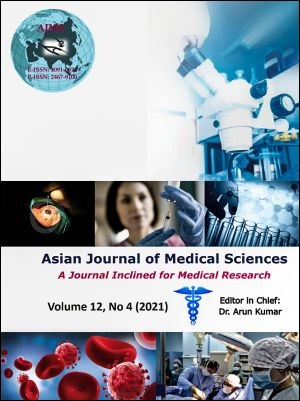Study on Human Cranial Index with its Sex Difference from Central Kerala
Keywords:
Identification, Sexual dimorphism, Human skull, Cranial indexAbstract
Background: Cranial index, primarily used as an indicator of race had been studied by various workers in view of its morphometric difference in sex prediliction. Hence it would be useful to identify sex of an individual from skeletal remains. Similar studies from our geographic region, if at all present might be very few.
Aims and Objective: Based on maximum breadth and length of skull the study aimed at whether there was any statistically significant difference in the cranial index of male and female.
Materials and Methods: We used 96 dry,intact skulls preserved in the departments of Forensic Medicine and Anatomy of various Medical Colleges in Kottayam, Ernakulam, Alappuzha and Pathanamthitta districts of Kerala state, India. Skull typed as male or female by observation method was measured for its maximum breadth and
length, cranial index derived and the data was entered against corresponding serial number. The data analysis was conducted using SPSS software.
Results: The mean percentage values of cranial index for female and male were respectively 77.68±4.53 and 73.71±4.05 with the p-value noted as 0.0001from their ranks determined by Mann- Whitney U test which
showed statistically significant difference in cranial index of the two sexes. Literature could reveal similar results in studies conducted by other authors.
Conclusion: Hence this morphometric study proved that it is valuable to include the application of cranial index in the identification procedure of skeletal remains. Further metric studies in this field are needed with a wider usage of other indices.
Downloads
Downloads
Published
How to Cite
Issue
Section
License
Authors who publish with this journal agree to the following terms:
- The journal holds copyright and publishes the work under a Creative Commons CC-BY-NC license that permits use, distribution and reprduction in any medium, provided the original work is properly cited and is not used for commercial purposes. The journal should be recognised as the original publisher of this work.
- Authors are able to enter into separate, additional contractual arrangements for the non-exclusive distribution of the journal's published version of the work (e.g., post it to an institutional repository or publish it in a book), with an acknowledgement of its initial publication in this journal.
- Authors are permitted and encouraged to post their work online (e.g., in institutional repositories or on their website) prior to and during the submission process, as it can lead to productive exchanges, as well as earlier and greater citation of published work (See The Effect of Open Access).




